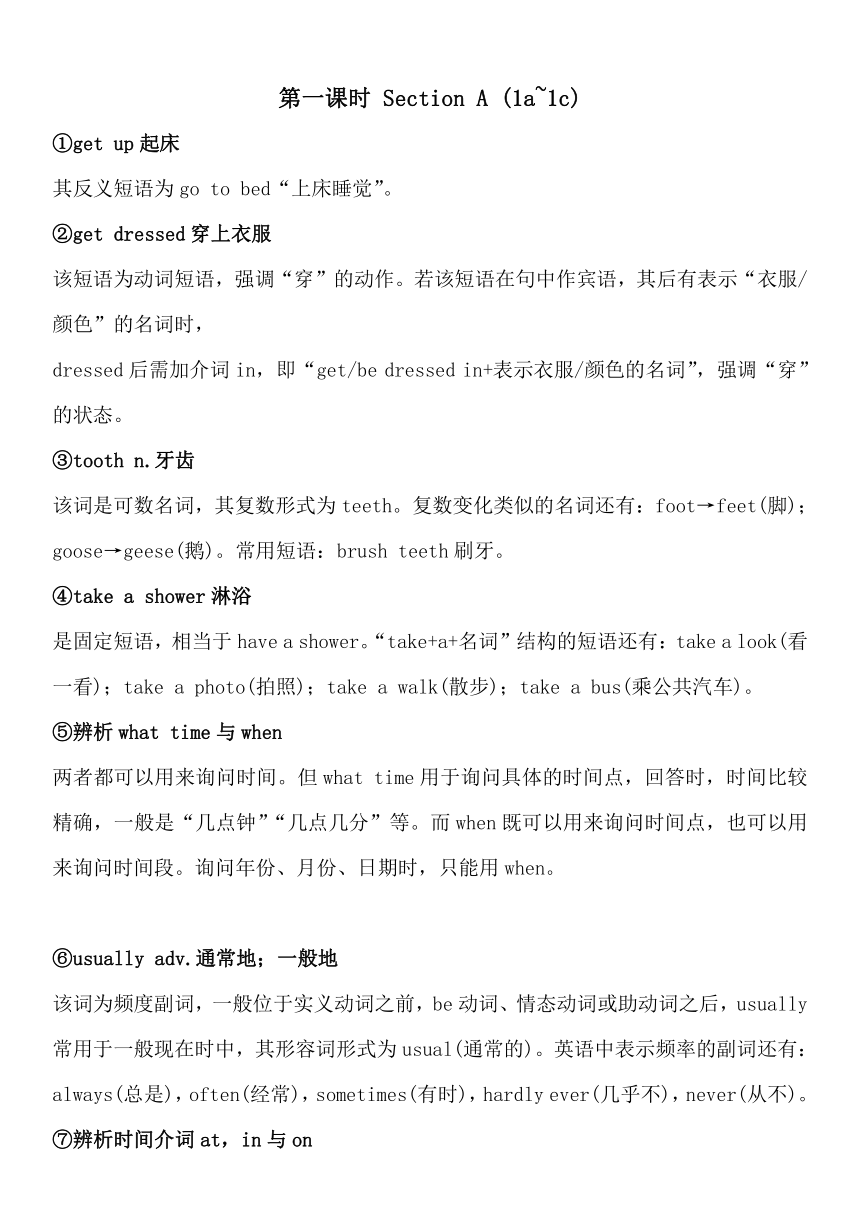人教版七年级上册Unit 2 What time do you go to school?第一课时 Section A (1a~1c)知识点 (含答案)
文档属性
| 名称 | 人教版七年级上册Unit 2 What time do you go to school?第一课时 Section A (1a~1c)知识点 (含答案) |  | |
| 格式 | docx | ||
| 文件大小 | 116.4KB | ||
| 资源类型 | 教案 | ||
| 版本资源 | 人教新目标(Go for it)版 | ||
| 科目 | 英语 | ||
| 更新时间 | 2024-03-24 18:19:44 | ||
图片预览

文档简介
第一课时 Section A (1a~1c)
①get up起床
其反义短语为go to bed“上床睡觉”。
②get dressed穿上衣服
该短语为动词短语,强调“穿”的动作。若该短语在句中作宾语,其后有表示“衣服/颜色”的名词时,
dressed后需加介词in,即“get/be dressed in+表示衣服/颜色的名词”,强调“穿”的状态。
③tooth n.牙齿
该词是可数名词,其复数形式为teeth。复数变化类似的名词还有:foot→feet(脚);goose→geese(鹅)。常用短语:brush teeth刷牙。
④take a shower淋浴
是固定短语,相当于have a shower。“take+a+名词”结构的短语还有:take a look(看一看);take a photo(拍照);take a walk(散步);take a bus(乘公共汽车)。
⑤辨析what time与when
两者都可以用来询问时间。但what time用于询问具体的时间点,回答时,时间比较精确,一般是“几点钟”“几点几分”等。而when既可以用来询问时间点,也可以用来询问时间段。询问年份、月份、日期时,只能用when。
⑥usually adv.通常地;一般地
该词为频度副词,一般位于实义动词之前,be动词、情态动词或助动词之后,usually常用于一般现在时中,其形容词形式为usual(通常的)。英语中表示频率的副词还有:always(总是),often(经常),sometimes(有时),hardly ever(几乎不),never(从不)。
⑦辨析时间介词at,in与on
三者都可用来表示时间。(1)at用于表示在某一具体的时刻或用于表示某一时间的固定搭配中。
(2)in用在月份、季节、年份等前面,也可以用于表示“在早上/下午/晚上”。
(3)on用在具体的日期、星期、节日前,也可用来表示在具体某一天的上午/下午/晚上。
Ⅰ.根据图片提示,用英语写出表示相应动作的单词或短语。
1.get up 2.get dressed 3.brush teeth 4.take a shower
Ⅱ.单项填空。
(B)5.There is shower at my home and I can take shower every day.
A.a;/ B.a;a C./;the D./;a
(C)6.I usually get up six thirty the morning.
A.at;on B.in;in C.at;in D.on;in
(A)7. up,Scott.It’s time to go to school.
A.Get B.Take C.Eat D.Go
(C)8.— do your parents eat breakfast
—At seven thirty.
A.Why B.What C.What time D.How
(C)9.My son can get by himself(他自己).
A.dress B.dresses
C.dressed D.dressing
Ⅲ.根据句意,用括号中所给词的适当形式填空。
10.The dentists advise us to brush our teeth three times a day.(tooth)
11.My brother goes to school at seven every day.(go)
12.There are forty students in our class,22 boys and 18 girls.(be)
13.The workers paint(涂颜料) the room with two brushes.(brush)
14.Tom usually has milk and bread for breakfast.(usual)
Ⅳ.将下列句子中中文部分译成英语,注意使用适当的形式。
15.I usually take a shower at 6:45.What about you (淋浴)
16.On weekends, John doesn’t need to go to school,because he has no classes.(去上学)
17.On weekdays,we must get to/arrive at/reach school before 7:30 in the morning.(到达)
18.Molly gets up at six forty.(起床)
①get up起床
其反义短语为go to bed“上床睡觉”。
②get dressed穿上衣服
该短语为动词短语,强调“穿”的动作。若该短语在句中作宾语,其后有表示“衣服/颜色”的名词时,
dressed后需加介词in,即“get/be dressed in+表示衣服/颜色的名词”,强调“穿”的状态。
③tooth n.牙齿
该词是可数名词,其复数形式为teeth。复数变化类似的名词还有:foot→feet(脚);goose→geese(鹅)。常用短语:brush teeth刷牙。
④take a shower淋浴
是固定短语,相当于have a shower。“take+a+名词”结构的短语还有:take a look(看一看);take a photo(拍照);take a walk(散步);take a bus(乘公共汽车)。
⑤辨析what time与when
两者都可以用来询问时间。但what time用于询问具体的时间点,回答时,时间比较精确,一般是“几点钟”“几点几分”等。而when既可以用来询问时间点,也可以用来询问时间段。询问年份、月份、日期时,只能用when。
⑥usually adv.通常地;一般地
该词为频度副词,一般位于实义动词之前,be动词、情态动词或助动词之后,usually常用于一般现在时中,其形容词形式为usual(通常的)。英语中表示频率的副词还有:always(总是),often(经常),sometimes(有时),hardly ever(几乎不),never(从不)。
⑦辨析时间介词at,in与on
三者都可用来表示时间。(1)at用于表示在某一具体的时刻或用于表示某一时间的固定搭配中。
(2)in用在月份、季节、年份等前面,也可以用于表示“在早上/下午/晚上”。
(3)on用在具体的日期、星期、节日前,也可用来表示在具体某一天的上午/下午/晚上。
Ⅰ.根据图片提示,用英语写出表示相应动作的单词或短语。
1.get up 2.get dressed 3.brush teeth 4.take a shower
Ⅱ.单项填空。
(B)5.There is shower at my home and I can take shower every day.
A.a;/ B.a;a C./;the D./;a
(C)6.I usually get up six thirty the morning.
A.at;on B.in;in C.at;in D.on;in
(A)7. up,Scott.It’s time to go to school.
A.Get B.Take C.Eat D.Go
(C)8.— do your parents eat breakfast
—At seven thirty.
A.Why B.What C.What time D.How
(C)9.My son can get by himself(他自己).
A.dress B.dresses
C.dressed D.dressing
Ⅲ.根据句意,用括号中所给词的适当形式填空。
10.The dentists advise us to brush our teeth three times a day.(tooth)
11.My brother goes to school at seven every day.(go)
12.There are forty students in our class,22 boys and 18 girls.(be)
13.The workers paint(涂颜料) the room with two brushes.(brush)
14.Tom usually has milk and bread for breakfast.(usual)
Ⅳ.将下列句子中中文部分译成英语,注意使用适当的形式。
15.I usually take a shower at 6:45.What about you (淋浴)
16.On weekends, John doesn’t need to go to school,because he has no classes.(去上学)
17.On weekdays,we must get to/arrive at/reach school before 7:30 in the morning.(到达)
18.Molly gets up at six forty.(起床)
同课章节目录
- Unit 1 Can you play the guitar?
- Section A
- Section B
- Unit 2 What time do you go to school?
- Section A
- Section B
- Unit 3 How do you get to school?
- Section A
- Section B
- Unit 4 Don't eat in class.
- Section A
- Section B
- Unit 5 Why do you like pandas?
- Section A
- Section B
- Unit 6 I'm watching TV.
- Section A
- Section B
- Review of Units 1-6
- Unit 7 It's raining!
- Section A
- Section B
- Unit 8 Is there a post office near here?
- Section A
- Section B
- Unit 9 What does he look like?
- Section A
- Section B
- Unit 10 I'd like some noodles.
- Section A
- Section B
- Unit 11 How was your school trip?
- Section A
- Section B
- Unit 12 What did you do last weekend?
- Section A
- Section B
